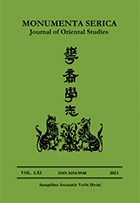
GAOSHANG YUHUANG BENXING JIJING (COMBINED SCRIPTURES OF THE ORIGINAL ACTS OF THE EXALTED AND SUPERIOR JADE SOVEREIGN) AN ANNOTATED TRANSLATION AND STUDY OF ITS FIRST CHAPTER
BONY SCHACHTER
Introduction
The Gaoshang Yuhuang benxing jijing 高上玉皇本行集經 (CT 10 and CT 11, Combined scriptures of the Original Acts of the Exalted and Superior Jade Sovereign; hereafter: YHJ) is the sole work of the Ming Daoist Canon devoted to the deity referred to by the title of the scripture. The YHJ is divided into three juan 卷 and five chapters. The first juan is formed by the first chapter. The second and the third juan comprise two chapters each. The first juan can be understood as an iconographical and hagiographical description of the Jade Thearch. The second juan praises the Perfected Writs (zhenwen 真文) of the Lingbao 靈寶 revelation and the merit of the Heavenly Thearch as its transmitter. The third juan exalts the benefits brought by recitation of the scripture and describes the penalties for improper attitudes against it. Our text narrates the story of the encounter of the Jade Thearch with a sacred assembly in the Pure Tenuity Heaven (qingweitian 清微天). There he manifests six powers and liberates his light throughout the world-systems of the ten directions.
……
This article can be divided into three parts. The first part discusses briefly the contributions of previous scholars and the evolving complexity of the Jade Sovereign’s identity throughout a selection of sources extending from the Six Dynasties to Qing times. This part deals with how different groups in Chinese society have formed their own images of the Jade Sovereign throughout history. The second part is dedicated to the problem of the scriptural reception. Hsieh Tsung-hui (Xie Conghui 謝聰輝) has demonstrated convincingly the relationship between the final redaction of the YHJ and the mediumistic cult of Zitong in the Sichuan area. Following his approach, I shall demonstrate the importance of this kind of ritual throughout the history of our scripture’s reception from the period of the Song to the 20th century. In the last part of this article, I would like to discuss – by means of the annotations accompanying the translation – what the choices related to the sources of the first chapter of the text, with its scriptural structure and content, might suggest in terms of the religious purpose and intended audience for our document.